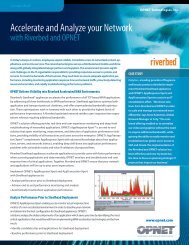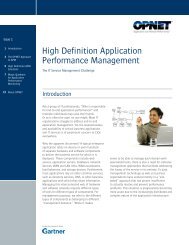You also want an ePaper? Increase the reach of your titles
YUMPU automatically turns print PDFs into web optimized ePapers that Google loves.
for reasonableness in accordance with ASC 360 Property, Plant and<br />
Equipment, or ASC 360. If changes in the Company’s assumptions<br />
at the time of future periodic reviews indicate that the carrying<br />
value of its acquired technology and purchased intangible assets<br />
exceeds their fair value and it determines that carrying amounts can<br />
not be recovered, it would result in impairment losses. As of March<br />
31, <strong>2011</strong> and 2010, intangible assets totaled $4.5 million and $5.1<br />
million, net of accumulated amortization of $11.9 million and $9.7<br />
million, respectively. There has been no impairment as of March 31,<br />
<strong>2011</strong> or 2010.<br />
Goodwill. In accordance with ASC 350, goodwill is not amortized<br />
but is tested for impairment annually during the Company’s fourth<br />
quarter and whenever events and circumstances occur indicating<br />
that the asset might be impaired. The Company performed its annual<br />
impairment test of goodwill as of March 31, <strong>2011</strong> and 2010 and<br />
concluded that the fair value exceeded the carrying value; therefore,<br />
it did not record any impairment. The Company has not recorded a<br />
goodwill impairment since it first recorded goodwill in fiscal 2001.<br />
Valuation of long-lived assets. In accordance with ASC 360,<br />
the Company reviews its long-lived assets, including property and<br />
equipment, for impairment whenever events or changes in circumstances<br />
indicate that the carrying amounts of the assets may not be<br />
fully recoverable. If the total of the expected undiscounted future net<br />
cash flows is less than the carrying amount of the asset, a loss is recognized<br />
for the difference between the fair value and carrying amount of<br />
the asset. There has been no impairment as of March 31, <strong>2011</strong> or 2010.<br />
Revenue Recognition. The Company derives revenue from three<br />
primary sources: (1) product, (2) product updates, technical support<br />
and services, which include product updates, training services on a<br />
when-and-if-available basis, and technical support, and (3) professional<br />
services, which include consulting and custom training<br />
services for customers without a current maintenance agreement.<br />
The Company recognizes revenue based on the provisions of ASC<br />
605-985 Software Revenue Recognition, or ASC 605-985.<br />
proDuCT revenue<br />
Product revenue represents all fees earned from granting customers<br />
perpetual and term licenses to use the Company’s software as<br />
well as the hardware that it uses to deliver its AppResponse Xpert<br />
software products. It excludes revenue derived from product<br />
updates, which are included in product updates, technical support<br />
and services revenue. For the years ended March 31, <strong>2011</strong>, 2010,<br />
and 2009, perpetual licenses represented approximately 91%,<br />
92%, and 93% of product revenue, respectively. Product revenue<br />
is recognized when the following four criteria are met: (i) persuasive<br />
evidence of an arrangement exists, (ii) delivery of the software<br />
has occurred, (iii) the product fee is fixed or determinable, and (iv)<br />
collectibility is probable. The Company defines each of these four<br />
criteria as follows:<br />
OPNET Technologies, Inc. <strong>2011</strong> <strong>Annual</strong> <strong>Report</strong><br />
35<br />
• Persuasive evidence of an arrangement exists. For license<br />
arrangements with end-users, it is the Company’s customary<br />
practice to have a written software license agreement, which is<br />
signed by both the end user and the Company, and a purchase<br />
order or equivalent. A written contract can be executed based<br />
on the customer-specific format or on the standard “shrink wrap”<br />
software master license agreement. For those end users who<br />
have previously negotiated a software license agreement with<br />
the Company, the initial software license agreement is used as<br />
evidence of a written contract. Sales to distributors, resellers,<br />
and value-added resellers, which the Company collectively refers<br />
to as resellers, are evidenced by a master reseller agreement<br />
governing the relationship, which is signed by both the reseller<br />
and the Company, together with a purchase order on a transaction-by-transaction<br />
basis. To further evidence an arrangement,<br />
the Company’s master reseller agreement requires that the<br />
reseller provide the Company copies of the end user’s executed<br />
software master license agreements.<br />
• Delivery has occurred. Physical delivery of the Company’s<br />
software products to end users or resellers, which are collectively<br />
referred to as customers, is generally considered to have<br />
occurred upon the transfer of media containing the Company’s<br />
software products to a common carrier (usually FOB shipping<br />
point based on standard agreement terms). Software licenses<br />
may also be delivered electronically to end users. Electronic<br />
delivery is deemed to occur after end users have been provided<br />
with access codes that allow them to take immediate possession<br />
of the software. If a software arrangement includes undelivered<br />
software products or services that are essential to the functionality<br />
of delivered software products, delivery is not considered<br />
to have occurred until these software products or services are<br />
delivered.<br />
• The fee is fixed or determinable. It is the Company’s policy to<br />
not provide customers the right to any adjustments or refund<br />
of any portion of their license fees paid, acceptance provisions,<br />
cancellation privileges, or rights of return. The Company’s<br />
normal payment terms for its software products and services<br />
currently range from net 30 days to net 90 days and primarily<br />
vary based on the country in which an agreement is executed.<br />
Payments that extend beyond the Company’s normal payment<br />
terms from the contract date but that are due within six months<br />
are generally deemed to be fixed or determinable based on its<br />
successful collection history on such arrangements, and thereby<br />
satisfy the required criteria for revenue recognition. Arrangements<br />
with payment terms extending beyond six months are<br />
considered not to be fixed or determinable, and revenue from<br />
such arrangements is recognized as payments become due and<br />
payable.




